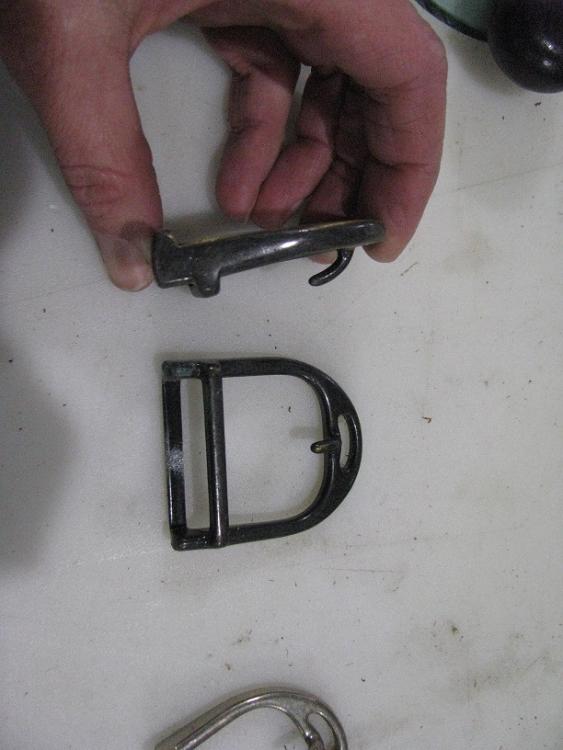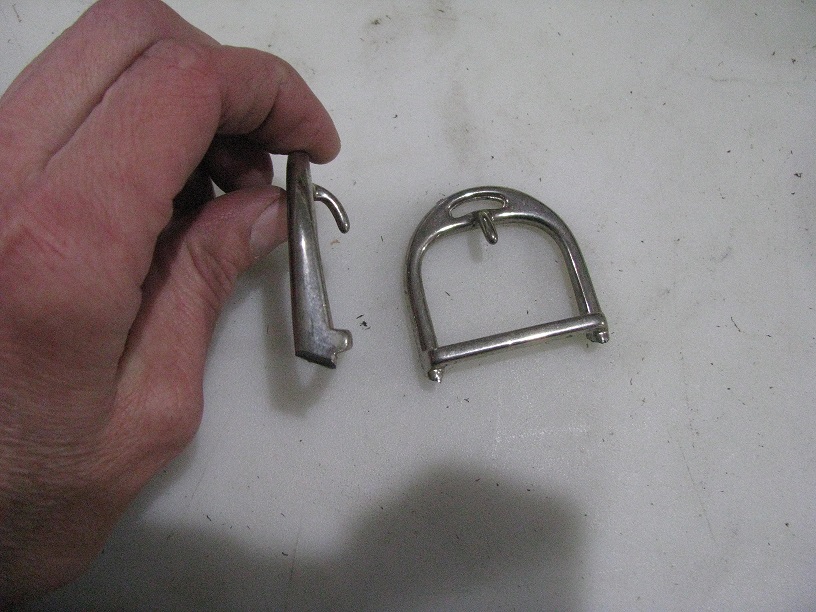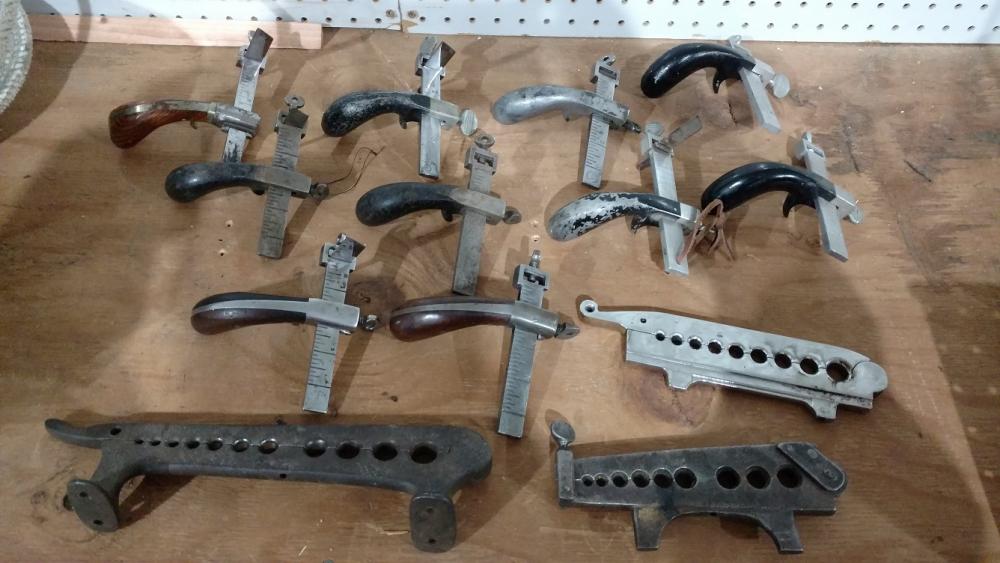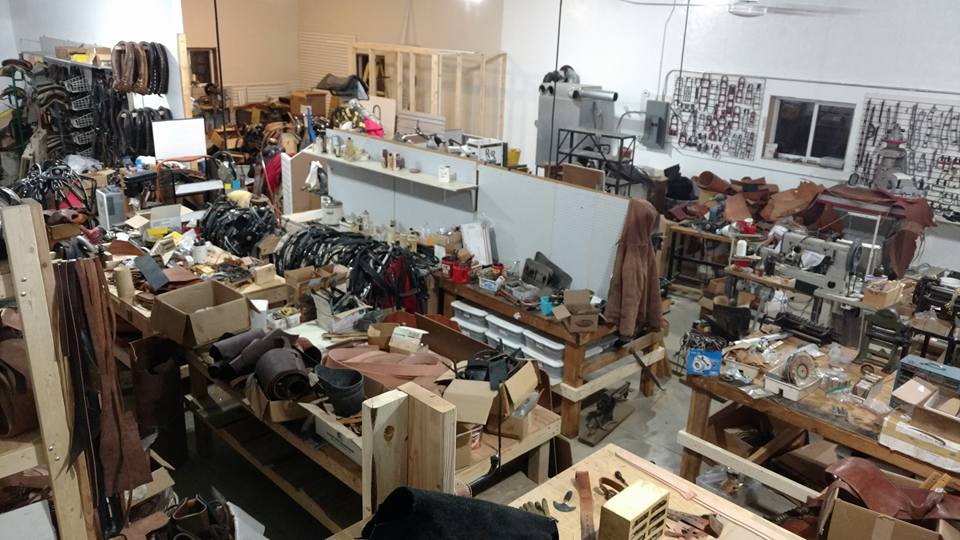-
Posts
1,039 -
Joined
-
Last visited
Content Type
Profiles
Forums
Events
Blogs
Gallery
Everything posted by Big Sioux Saddlery
-
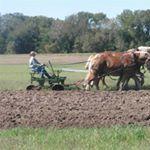
Headstalls
Big Sioux Saddlery replied to T Moore Medicine Hat Saddlery's topic in Leather Sewing Machines
Sure I'll find something and get a pic. The "fish" pattern is just my own term, I've never heard anyone call it that before. I figured it would make it easier to visualize, but apparently, I failed. I've sewn them on a Randall, Union Lock and a 441 clone. Randall would be my first choice. Besides of the fact that their design facilitates sewing close to the buckle, there has never been another machine that can lay down as pretty of a stitch. Landis 3 is a close second of the hook and awl machines. Union Locks can be a tough machine to get along with. They are made for high speed production, as opposed to a small shop that does many different kinds of work. But the design of the throat makes it easy to sew the center bar buckles. Currently I have been using a 441 clone, only because for the past 6 years, until this last month, I have been seriously limited on space. I needed to use the space I had available for machines that were the most versatile. I do a moderate amount of synthetics sewing, and the hook and awl machines can't sew synthetics. So I had the clone set up, and another heavy machine to specifically sew rounds and tugs (Landis One). Before too much more time goes by, I will have all the machines I own set up and useable, without spending a half day moving stuff to get to them! -
Anyone needing a splitter like this better sit up and take notice. Blade clamp missing or not, I think this is a good deal. Of everything that could be missing, I imagine a blade clamp would be as easy to make as anything. If I'm wrong Bruce can set me straight:-) If this thing was in my area, I'd already own it, and I don't even need one!
-

Headstalls
Big Sioux Saddlery replied to T Moore Medicine Hat Saddlery's topic in Leather Sewing Machines
It's the design of the machine you are using that makes it difficult to sew up close to a center bar buckle. The design is very similar to a Landis 1 and a Bauer, and is the main drawback to those machines. I'm not aware of any plates available for these machines to allow easier sewing of that type of buckle. Greg Gomersall is very knowledgeable on the Pearsons, and would know if there ever were raised plates available for them. As Wiz mentioned, a Campbell/Randall type of machine (Landis 3 is very similar in design), or a Union Lock, Landis 16, makes sewing up to those buckles much easier. Second would be the 441 type machines. Because the cylinder arm is flat on these machines, they are not quite as easy to sew the center bar buckles on as those previously mentioned. While raised plates are available for the 441's, you loose height capacity. I nearly always sew that type of buckle in with a "fish" type of pattern; Start up as close to the buckle as you can, cross over diagonally and sew down the lap to a point, turn your work and sew back up, crossing over again to the opposite side when you get near the buckle. It takes some practice to get proficient at it. Never, ever sew straight across a strap on anything designed for equine use. You basically create a "tear-line" for the strap under stress. You can sew straight from and back up to the buckle, but won't be able to get as tight of a fit. Loose hardware in the tack business equals sloppy work. I put a wedge in at almost every piece of hardware when I'm building harness. The tack industry has become flooded with budding "tack makers" since the Chinese clone machines became easily and cheaply available. The sewing by some of these people is horrendous. . . they know absolutely nothing about basic construction principles. Their goal is to produce flashy, blingy tack for the barrel racing crowd. I guess if the stuff they are making lasts long enough for the fad to fall out of fashion, then it probably really doesn't matter. I just can't bring myself to cut corners. -

What Is This Piece of Hardware?
Big Sioux Saddlery replied to Big Sioux Saddlery's topic in Hardware and Accessories
Yes, Tom, the first picture was taken with my smart phone. However, I went back out and took a picture with my digital camera this morning, because I know that has worked in the past for this site, if I shrink them in size. And I THOUGHT I posted them here this morning, but it seems I did not. I just have a lot going on right now! Lol. Anyway, here are the pics (hopefully) if anyone is interested. Thanks again Tom! -

What Is This Piece of Hardware?
Big Sioux Saddlery replied to Big Sioux Saddlery's topic in Hardware and Accessories
Thank you Tug, that is the closest I've seen. I did a Google Image search and came up empty. On mine, the bars are offset from each other, so not like the stirrup tread on an English saddle at all, but I guess if the designer needed to take some artistic license to make the buckles function better, then that's what they must be. I rode English horses all through high school and professionally for several years after high school, and they just didn't look enough like an English stirrup to me to call them that. Two dimensionally, yes, but not when I had them in my hand and looked at them from all angles. In any case, I must have a couple hundred of them if anyone wants some! -

What Is This Piece of Hardware?
Big Sioux Saddlery replied to Big Sioux Saddlery's topic in Hardware and Accessories
Well, I gotta fix the picture, because they aren't mini English stirrups, and they aren't just dee rings, although I have to admit, with what is visible, they look like they could be either one. I tried enlarging the picture, and it just got blurry. There is a curved hook at the top of the piece, like it is intended to hook into a strap, and the bottom (the part that looks like the tread on an English stirrup) has a couple of bars spaced like a strap is supposed to feed through and back around, or something. The frame is way too light to be any type of hardware used on any equine equipment, so I ruled that out right away. I'll take some more pics tomorrow. -

What Is This Piece of Hardware?
Big Sioux Saddlery replied to Big Sioux Saddlery's topic in Hardware and Accessories
Well the picture shows up so dang small I can't even see it once it was posted. So someone tell me how to fix that, please! -
I've had a box full of these for a long time. I don't even remember where it came from, but it was in with a large lot of harness and saddlery hardware, or came with a shop buyout. The chrome or nickel plated ones all have a piece cut off of them, and I'm assuming they were identical to the black/brass ones when new. They are about 1-1/2" wide and maybe a couple inches top to bottom.
-
I bet you did get funny looks from the folks in the car! I personally am not a fan of Wade saddles; I am a swell fork girl, always have been. Part of that could be that I've never ridden a Wade that I built for myself. I'm not very big, and the Wades I've ridden have been a couple inches too big for me, but I like my swell fork saddles, so I haven't been motivated to build a Wade for myself. I think you should be able to get all the forward movement with a Wade that you would want. Comparing it to a swell fork is a very general comparison, because there is so much difference in swell forks. A front with a lot of undercut and leg cut, such as that Bull Moose, will allow for more forward swing than something with less undercut and no leg cut and a big rounded front, but even with those you can usually get all the forward swing you'd need. Understand also, there is a difference between forward swing and forward hung. You do want your saddle to be balanced in that your stirrups hang underneath you, and for the most part, stay there. Stirrups hung too far forward can be as bad as hung too far back. Use the slots in the underside of the bars as a guide for your top slots. For me, the goal is to be able to swing ahead if needed. People who have never ridden anything but western saddles don't realize how much they depend on that 3" stirrup leather to stabilize their legs until they ride an English saddle, and then their legs fly forward because they have been bracing with their feet against 3" stirrup leathers and 8" fenders and don't even realize it. Bareback is great for balance, and I had to ride bareback until I was big enough to saddle my own horse, but try riding an English saddle once. I won't say it's more difficult than riding bareback, but it is sure different, especially the so-called "Lane Fox" cutback flat saddles used on the show walkers and Saddlebreds, as there are no knee rolls or thigh blocks on those.
-
Stirrup slots in the ground seat like you have drawn in the second picture would definitely help obtain some forward swing to your stirrup leathers. However, the pattern of the rigging also plays a big part in how free they feel. If most of the saddles you've ridden have locked your feet back behind you, chances are you've ridden mostly arena roping saddles. Arena ropers don't want free swinging stirrups. When I was in high school, I had an Arab mare that liked to crow hop every once in a while. I was riding an old Hereford roping saddle at the time. I could stick with that mare better bareback I think than in that saddle. I didn't realize it at the time, but the saddle was positioning me to get dumped. Once I switched to a saddle that I could get my feet ahead a little when she dropped her head, I could ride her easy. A lot of the arena roping saddles have the rigging leather actually taking the place of the front bar riser, with a lot of leather behind the swell to keep that stirrup leather back there. I've even seen binds to keep the leathers back on some roping saddles. Most of the saddles I build go out to the country to guys who are going to do a little of everything on them, but not much arena roping. They want something that they can ride in for hours, and I usually try to get as much freedom in the stirrup leathers as possible. The style of the fork can have some effect also. A cut-under style front like in your picture will allow for more forward swing than a swell with no cut-under that comes further down and further back on the bar. On re-rawhiding the tree, unless it is a really high quality tree to start with, and/or the leather parts are still in good condition, I wouldn't bother. If you have to replace all or most of the leather parts, you might as well start over with a decent tree and have something when you're done. That however, is just my opinion.
-
That made me laugh! Wait til you see my sewing machines. Honestly, I bought my first one from a tool trader and it is still my favorite. Just has a good feel to it and it draws beautifully. Then through the years I'd buy one here and there on an auction or get a couple when I bought out some shops, and my intention was to have every one adjusted to a specific size so I'd never have to change one. Never have done that because up until now, especially the last 7 years, I never had enough space to have more than one on my bench at a time, and no room to hang them. Now I will, but we'll see if I follow through with my intention.
-
Will do, I've got two, although they're either American or Landis, I never can remember, so we're 2/3 of the way there. Lol. I can't believe how much I've forgotten I had. There are at least 3 more draw gauges than what are in the picture. Out of all of them, there are really only two that I like to use. Funny how we get used to the feel of a certain tool, and prefer that over others, kind of like my round knives. I'll get a picture of them also when I get them all in one place.
-
A little different perspective on what the shop looks like right now. Still have some of the bigger machines to move, I just have to find a day when at least two of my boys can help at the same time. It's a huge job to get everything set up and organized.
-
I've not had good luck with poly, however, I've gotten some bad nylon also. Some of it just comes down to being poor thread to start with. I don't know if it would be a random bad spool, or a bad run. Most of the time, thread that won't work on top can be used on bobbins, but I've even had thread that didn't work on the bottom. None of it was "bargain" or "odd lot" thread. It was all standard stock from reputable companies.
-
I believe Ken is correct in stating that bullhide is simply the heaviest, unsplit hides available. They may or may not be from a bull. Likewise, hides that are called steer hides are not necessarily from steers. As I understand it, they are classified by weight and size when still in a raw state, and labeled accordingly. I can verify that the best rawhide comes from an old skinny cow, the thinner the better. The hide off a thin cow cuts up smooth and glassy, whereas a hide from a fat critter has too much grease in it to work up nice. I have been told that the only difference between hides from black critters or hides from red critters (all else being equal) is that the red hides have a better, lighter color. The black hides do produce a fairly dark rawhide and the only red hides I've had came from calves, so it isn't really a fair comparison. Sorry, I guess we've gotten a long way from the Wade tree!
-
If you were using Wickett's traditional harness, you might have a chance of getting it to stick, but anything with oil and wax is gong to give trouble. At best, used in combination with clamps or tacks in the stitch line, it might hold well enough to get it sewed up, but I doubt it will create a long-lasting bond. I use a lot of harness leather from both Wickett and Hermann Oak, and I rarely use glue. If I do, it's in conjunction with shoe tacks which I pull out as I sew.
-
If you are willing to spend 400-500 on a tree, by all means go with a handmade tree. Rod Nikkel quit making trees at least a year ago, and sold all of his equipment, I think. I may be mistaken, but I don't think that the hand made tree guys exclusively use bull hide. And I might be mistaken about this as well, but it isn't so much about thickness (to a point) as it is a nice, tight job of rawhiding. The thicker the hide, the harder it will be to get it to suck down tight into every place that it needs to be. I'd like a tree maker to verify this for me, but with just the amount of rawhiding I've done personally, I think using the right parts of a decent cowhide would be thick enough for most trees. The other end of the spectrum would be the cheap Mexican trees covered with multiple pieces of goat rawhide just nailed and tacked to the tree. It's thin enough to tear by hand.
-
What do you feel is a decent price? You kind of get what you pay for with saddle trees. Even halfway decent production trees are $300-$400 anymore. The handmade trees seem to start around $600. I think the next handmade tree I order, I'm going to give Dusty Smith of WYO Custom Saddles a shot. He trained under Rod Nikkel, and I've liked what I've seen from him so far. But there are many good makers out there. Otherwise, I have bought several production trees from Timberline and been fairly pleased. Their trees are a little "neater" and the rawhiding a little nicer than the other production companies.
-
I love your living room, Jake!
-
Another interesting thread, as I am currently moving my operation into a new building. I will have more room than ever before, and even though I have been doing this for a living for 25 years, I know there will still be some changes to the setup after I get back in production. The type of work will largely determine your needs, as stated above. A separate dyeing/finishing area for me is an absolute necessity. I have just spent the last 7 years in the worst setup I've had since I started, and I can't count how many things I ruined by not having enough room and contaminating something with black dye, that was not supposed to be black. It makes you invent new words! The new shop has 5 separate 4 x8 tables. Three of them I just built new, and I beefed them up over what I previously had. They are made entirely from 2 x 6 framing, and they have a shelf underneath. My old tables were 2 x 4 construction, and have done ok, but did notice when I moved them a couple days ago, that they had really loosened up. So when we set them back up at the new shop, I beefed them up. Three of the 4 x 8 tables are intended to be strictly for cutting and layout. That means that nothing will be allowed to be on those tables besides what I am cutting today, or what got cut yesterday, or laying out patterns on a side. We'll see how THAT plays out! Three tables might seem overkill for a one person shop, but I have the room available, so I'm going to use it. I spent so many years cutting leather on my living room floor, because my shop tables were so full of stuff that didn't belong on a cutting table, that I never want to cut leather on the floor again. My knees are just too damn old! I'll have a couple tables dedicated to bench machines and fitting up, tacking, etc, and then the dying/finishing table, which is a 4 x 8, but spilt down the middle by a "wall" with pegboard on both sides. I've put a shelf for bottles on each side of the pegboard, and lights under the shelf. One side is for black stuff, the other for stuff that is to remain "dyeless". I will have a separate bench for tooling, mostly because I had a 6 ft space to fill in front of a window, and a bench that will fit there. I find myself avoiding tooling as much as possible, sue also to the arthritis in my hands. But I do enough that it will be nice to have the dedicated space, plus I like the view out that window!. Machinery will be placed wherever it makes sense. . .still haven't gotten to that point. I also want an area for grinding, and cutting bolts, etc away from the leather stuff to avoid contamination by metal filings. A set of wrenches and sockets and other general tools need to be kept in that area also. I still haven't decided where that is going to be.
-
Lots and lots! Like 7, that's SEVEN lbs of black 277 thread when I really only ever need two lbs at any given time. Bags and bags of hardware that I'd doubled and tripled up on when I couldn't find the first bag. For the last 7 years I've been cramped into an old, cold, dark farm shop building. It was supposed to be 6 months at the most, but many of you know how a divorce can go. During that time I had inventory stashed in every room in my house, a semi trailer, my garage, my horse trailer, and my barn, besides the building I was working out of. It was a miserable hellish seven years. Ultimate goal is too have a place for everything, and everything in it's place. As it was, I'd spend way too much time looking for stuff, and my efficiency was terrible. I've dreaded this move at the same time knowing that things would not get better until after the move. I still have nightmares from the last time I moved, and that was just my household stuff! The clicker dies I've accumulated over the last 25 years, from a number of places. The first ones I got from Big Sky Die, and they aren't around anymore. Quite a few I got used, and aren't marked so Idk where they came from. I have some from Texas Custom, Cut Rite, International, Viking. Unless I've been away for a few days, I can't smell the leather anymore. Once in awhile, if I get a new batch of quite a few sides at a time, it'll smell good for a few days, but that was in a much smaller space. I'm not sure with as much space as the new shop is, it'll be concentrated enough to smell it. Everyone else takes a deep breath when they come through the door and comment on how good it smells, so I guess a person gets somewhat "immune" to it. Too bad that doesn't happen with the glue!
-
If I was 25 years younger, I'd think about it. I absolutely don't want to make boots for the public, and that's a lot of money just to make a couple pairs for myself. Not saying her course isn't worth it, just that it wouldn't be worth it for me. Right now a vacation sounds good though, to somewhere that it doesn't take 15 minutes to get dressed to go outside, and then once you're out there you realize you have to go to the bathroom so you go back in, take everything back off, do your business, then get dressed all over again. Yep, that's getting real old and it's only the first week in January.
-
I would like to make a couple pairs of boots for myself someday, sooner rather than later. But dang they're intimidating! I started doing leather work about 40 years ago, so I guess you could say it's taken me 40 years to acquire my "collection". That makes me feel kind of old, now that I see it in print.
-
I can't make boots and shoes, and I don't do clothes. I'm really looking forward to getting everything completely set up. Most of the heavy machines are still at the old shop. Bench machines are scattered here and there, everywhere but on the benches.
-
Just chaos here, no organization whatsoever. Well maybe the clicker dies! I did that about 3 weekends ago, when there really wasn't any pressure.



